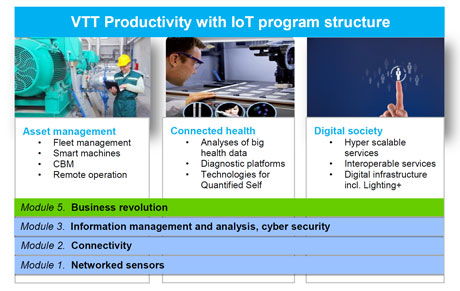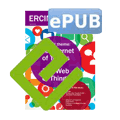y Heikki Ailisto, Nadine Pesonen, Pertti Raatikainen and Jonathan Ouoba
Internet of things (IoT) and the related Industrial Internet are recognized as one of the most significant technology-driven disruptions of the coming ten years. VTT Technical Research Centre of Finland has chosen IoT as a strategic area for research, development and innovation projects.
The Pro-IoT spearhead programme focuses on three technology areas, namely sensing technology, connectivity, and data-analysis with data security. These areas emanate from the needs expressed by European and especially Finnish companies, as well as on the strong competencies found in our research centre. Each area is delineated in three domains that represent challenges for our societies: industrial asset management, connected health and digital society. In addition to the technological perspectives, the business aspects are also investigated, through a dedicated module, hence making it possible to point out the relevance of the proposed solutions for companies. The complete structure of the programme is presented Figure 1.

Figure 1: VTT productivity with IOT program structure.
In order to sustain living standards in Europe, an increase in the productivity of companies appears to be vital. As such, the structure of the Pro-IoT programme is intended to provide the appropriate framework to initiate and maintain a productivity leap corresponding to the potential of IoT-based systems.
Research Highlights
The development of the Pro-IoT programme has resulted in many research projects. These projects have yielded significant achievements in various domains. A notable example, in the field of sensing, concerns wireless and battery-less devices, which represent a kind of Holy Grail. Such a paradigm would enable measurements in demanding conditions with low maintenance cost and without hindering production. VTT has developed a solution for measuring temperature, inclination, humidity, strain and other characteristics from machines and inside structures (e.g. walls) at distances up to 10 m, without batteries in the sensor. The principle is based on powering the sensor with radio frequency energy waves and using the return transmission to read out the resulting data (see Link ‘Zero Power Sensor’). The IPR protected technology allows for several individually identifiable sensors to be operated in the same space.
Another relevant example concerns autonomous vehicles and machines with communication needs. A solution for communication in demanding conditions, namely a cluttered harbour environment, has been developed for and tested in Port of Singapore. The key issue was how to ensure reliable communication with predictable maximum delay between moving machines for their safe operation. The solution involved using two or more communication networks seamlessly to secure communication between piles of containers and other ‘non-radio-friendly’ objects.
At a more conceptual level, other research activities were intended to address the issues related to the multi-technology environment of mobile devices. Indeed, many of these devices (mobile phones, sensors, wearable objects) are endowed with multiple wireless technologies. This offers opportunities in terms of services and applications to deploy, provided that solutions are designed to effectively manage the multi-technology context. Therefore, a platform has been developed for energy-efficient communications between mobile devices that identifies the most appropriate combination of technologies for different exchanges [1].
Impact on Industry and Society
The disruption caused by Industrial Internet is comparable to earlier industrial revolutions initiated by steam, electricity and computers. Indeed, General Electric predicts extra growth globally worth 10 to 15 trillion US dollars during the next 15 years. This will depend largely on being able to leverage industrial internet technology to the full [2]. As such, the Pro-IoT programme contributes to this evolution by providing companies with appropriate tools to improve the performance of their industrial processes. As shown by the examples in the previous section, the emphasis is on realistic solutions adapted to a challenging environment, safe autonomous systems while targeting a reduction in the operating costs.
The Industrial Internet will not only increase productivity in industry and firms. By adapting its models to urban areas, it will also affect public services with the emergence and the consolidation of smart cities. The everyday lives of all of us as employees, consumers and citizens will benefit from it with more personalized and efficient end-user services.
Challenges Ahead
The Industrial Internet is not happening by itself; it requires coordinated and intensified research effort involving the key stakeholders. We need to further address technological questions such as the need of more energy-efficient communication, the congestion of the Internet with the deployment of tens of billions of new nodes (sensors and smart objects). In addition, we have to find sustainable answers to the recurrent questions of information security and privacy in this new context. The safety aspect of the operations regarding autonomous machines, the issues of data ownership, as well as plausible and fair business models also represent major concerns.
Links:
The Pro-IoT spearhead project: http://www.vttresearch.com/impact/new-innovations-are-here/innovation-programmes/productivity-with-internet-of-things
Zero Power Sensor: http://knowledge.vtt.fi/ZeroPowerSensor
References:
[1] S. Chaumette and J. Ouoba: “A Multilevel Platform for Secure Communications in a Fleet of Mobile Phones”, in proc. of MobiCASE 2014
[2] P. Evans and M. Annunziata: “Industrial Internet: Pushing the Boundaries of Minds and Machines”, 2012, http://www.ge.com/docs/ chapters/Industrial_Internet.pdf
Please contact:
Ailisto Heikki
VTT Technical Research Centre of Finland
E-mail











